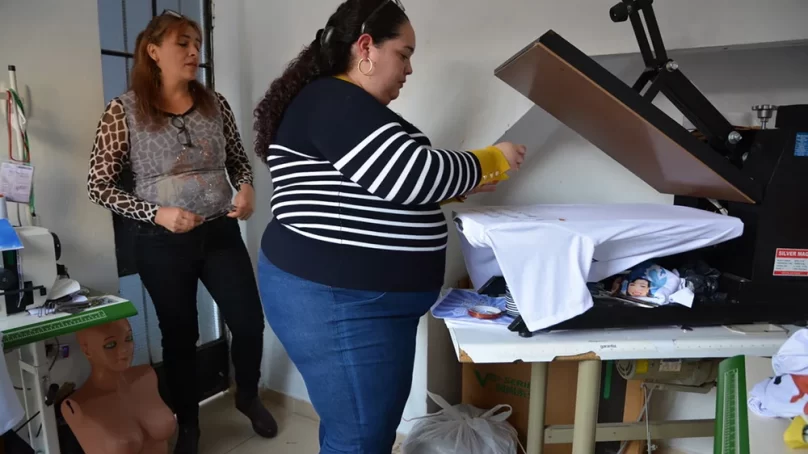
After travelling more than 3,000 kilometres from Venezuela, most migrants arrive in the northern border region of Tumbes, Peru, often malnourished and with urgent medical needs, according to aid groups at the border.
Due to recent restrictions on entry into Peru, most now use clandestine border crossings, where they are at the mercy of people smugglers and drug traffickers.
Ahead of Colombia in offering Venezuelan migrants a two-year version of temporary status in 2017 and 2018, Peru used to be more welcoming but has since taken a harsher line on migrants amid growing political and social pressure and mounting xenophobia.
Since Peru’s temporary stay programme (the PTP or Permiso Temporal de Permanencia) wrapped up in 2020, migrants have had two options: apply for a one-year Temporary Permanence Permit (CPP) card, which, like the PTP, acts as a kind
The CPP puts the many Venezuelans who may have entered Peru since late 2020, in legal limbo. It also requires applicants to present official documentation when applying. As a result of the new restrictions, illegal crossings are expected to increase, while economic inclusion, access to services and protection is being denied.
During his election campaign in 2021, President Pedro Castillo, a former rural school teacher who appealed to poor and Indigenous communities, threatened to expel migrants, feeding into the wider xenophobic discourse propagated by several other presidential contenders.
In December, he planned a repatriation of 41 Venezuelans by plane, before Caracas refused to authorise the landing of the flight and the migrants were set free again in Lima.
An International Rescue Committee (IRC) survey published in March estimated that 46 per cent of Venezuelans were living under the poverty line of $88 in weekly family earnings – at an average level of $79 – with many having to rely on assistance from family, friends, humanitarian groups or soup kitchens for food assistance.
Xenophobic statements and actions by elected officials, including the sudden expulsion of foreign sex workers ordered by the mayor of the northern town of Piura, has contributed to public antipathy towards Venezuelan migrants.
“There has been backstepping through political messaging by the government itself on the issue of deteriorating public security in the country, which they ironically attribute to the migrants, who they claim never provided anything,” said Matilde Cobeñas, Peru’s deputy ombudsman for children.
“We cannot say that officials are all aligned in the same discourse, in understanding protection towards migrants, particularly of the most vulnerable, such as children,” Cobeñas says. “Officials need to understand that migration is a right.”
In a recent study looking at the challenges school-aged Venezuelan children face in accessing education in Peru, Save the Children reported that nearly 10 per cent of those not attending school had experienced exclusion or discrimination by school directors and parents of other students when they applied for a spot.
“It’s a warning,” said Nelly Claux, programme quality director of Save the Children in Peru. “These feelings of hatred and rejection towards the migrants permeate throughout society.”
A raft of administrative barriers – such as a lack of official ID documents that are difficult for migrants to obtain, age limitations for children who may have fallen back in learning, or an inability to register on the one annual date allowed – have made school attendance harder.
In spite of growing violence against migrants in Chile’s northern border region since late 2021, the draw of one of Latin America’s highest-income countries for Venezuelans endures. Many continue to arrive with the goal of joining family members and finding jobs and security, after braving high-altitude crossings from Bolivia and Peru.
A lack of official documentation, which makes it harder to secure fixed employment, leaves many stranded in unwelcoming northern urban areas, unable to travel south towards the capital. The UN’s refugee agency, UNHCR, has increased its presence in the border region, where at least 21 people died attempting to enter the country in 2021.
Once across the border, migrants find themselves in another inhospitable area, both climatically and due to the unfriendly welcome they often receive from locals. Getting to the closest city, Iquique, some 235 kilometres away, is challenging – drivers can be fined for transporting irregular migrants, so many end up walking at least part of the journey.
Since February, when a new migration law allowed for the expulsion of migrants and asylum seekers who enter the country illegally, concern has grown over pushbacks. Of particular concern are expulsion back to Bolivia’s remote southern regions, where conditions are harsh, and where basic services are lacking for the marginalised Indigenous population, let alone for migrants.
The new legislation only affords legal status to migrants who entered the country on a permit granted before March 2020, when borders were shut due to the pandemic. Applications for residence visas must now be made and completed from abroad, a challenge for most migrants who lack proper documentation and job qualifications. Summary deportations of anyone known to have entered Chile illegally have been strengthened by the law.
Ahead of the November 2021 elections, anti-migrant protests and strikes by truck drivers led the government to deploy troops to the northern region as part of its wider policy to “put the house back in order”.
Before his inauguration in March, President Gabriel Boric had promised to prioritise the migration situation in response to predecessor Sebastián Piñera’s militarisation of the crisis. But public pressure, amplified by the Covid-fuelled economic downturn, led him to extend earlier manu militari measures.
Jenny Barchfield, UNHCR’s spokesperson for South America, said that funding shortfalls are threatening the agency’s ability to provide protection and support migrants in the country.
Initially used more as a transit route to other destinations, Brazil has witnessed a growing number of Venezuelans – including some from Indigenous communities in the country’s border regions, arriving with the intention of staying.
- The New Humanitarian report











